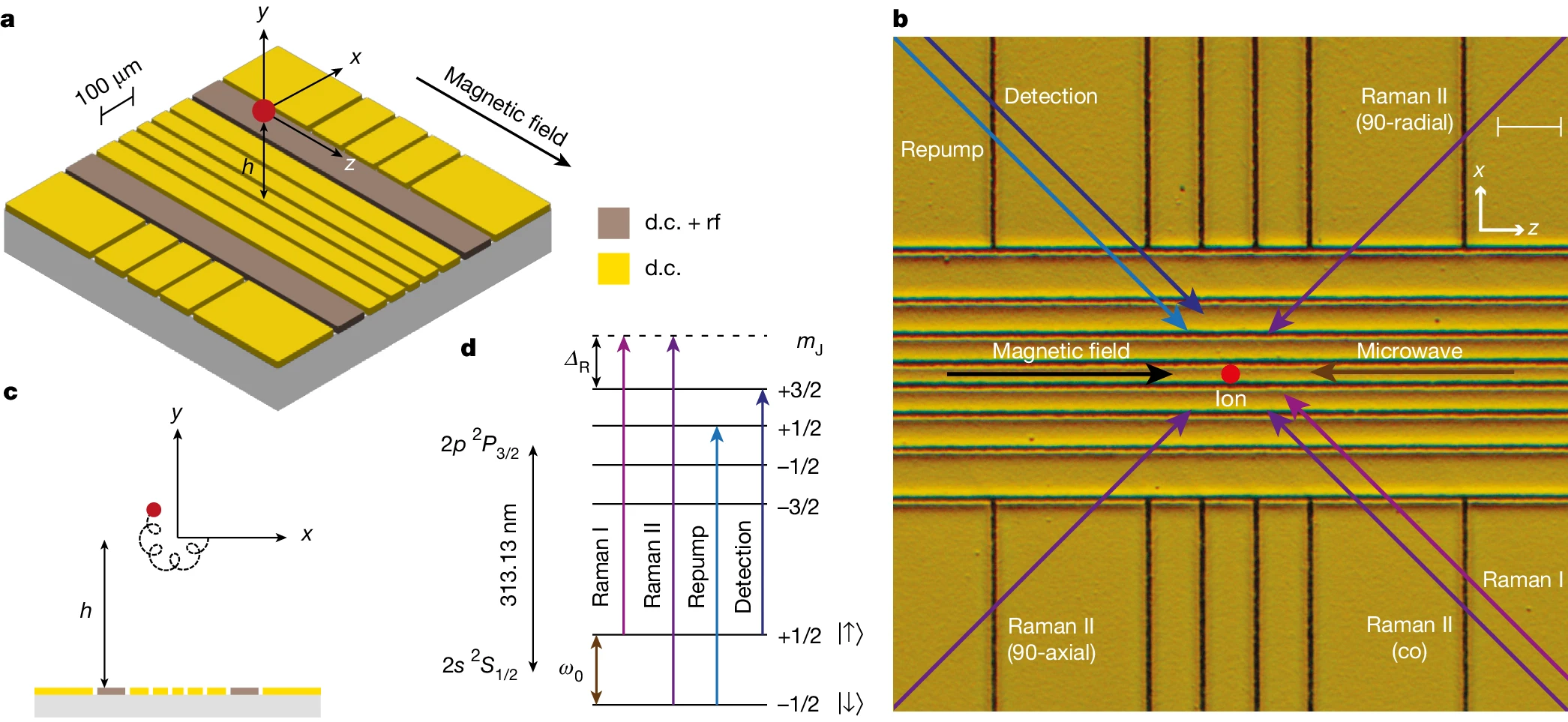The Penning ion trap replaces the radiofrequency field with a 3T magnetic field, overcoming challenges associated with scaling, such as high voltages and power dissipation for Ion Trap Qubits. The Penning trap allows for the transport of ions in three dimensions, enabling flexible reconfiguration of the array with low spatial overhead. This development could facilitate large-scale trapped-ion quantum computing, quantum simulation, and quantum sensing. The team demonstrated quantum control of an ion’s spin and motional degrees of freedom, a key ingredient for scaling based on the Penning ion-trap QCCD architecture.
What is the Potential of Trapped Ions in Quantum Computing?
Quantum computing is a rapidly evolving field, and trapped ions in radiofrequency traps are among the leading approaches for realizing quantum computers. This is due to their high-fidelity quantum gates and long coherence times. However, the use of radiofrequencies presents several challenges to scaling, including requiring compatibility of chips with high voltages, managing power dissipation, and restricting transport and placement of ions.
A team of researchers, including Shreyans Jain, Tobias Sägesser, Pavel Hrmo, Celeste Torkzaban, Martin Stadler, Robin Oswald, Chris Axline, Amado Bautista Salvador, Christian Ospelkaus, Daniel Kienzler, and Jonathan Home, have developed a microfabricated Penning ion trap that removes these restrictions by replacing the radiofrequency field with a 3 T magnetic field. They demonstrated full quantum control of an ion in this setting and the ability to transport the ion arbitrarily in the trapping plane above the chip.
This unique feature of the Penning microtrap approach allows for modifying the quantum charge-coupled device architecture with improved connectivity and flexibility, facilitating the realization of large-scale trapped-ion quantum computing, quantum simulation, and quantum sensing.
How Does the Penning Microtrap for Ion Trap Qubits Approach Overcome the Challenges of Scaling?
Scaling the system size to support orders of magnitude more qubits seems highly challenging. One of the primary paths to scaling is the quantum charge-coupled device (QCCD) architecture, which involves arrays of trapping zones between which ions are shuttled during algorithms. However, challenges arise because of the intrinsic nature of the radiofrequency (rf) fields, which require specialized junctions for two-dimensional (2D) connectivity of different regions of the trap.
An alternative to rf electric fields for radial confinement is to use a Penning trap, in which only static electric and magnetic fields are used. This is an extremely attractive feature for scaling because of the lack of power dissipation and geometrical restrictions on the placement of ions. Penning traps are a well-established tool for precision spectroscopy with small numbers of ions, whereas quantum simulations and quantum control have been demonstrated in crystals of more than 100 ions.
However, the single trap site used in these approaches does not provide the flexibility and scalability necessary for large-scale quantum computing. The Penning QCCD can be envisioned as a scalable approach in which a microfabricated electrode structure enables the trapping of ions at many individual trapping sites, which can be actively reconfigured during the algorithm by changing the electric potential.
What is the Main Advantage of the Penning QCCD Approach?
The main advantage of the Penning QCCD approach is that the transport of ions can be performed in three dimensions almost arbitrarily, without the need for specialized junctions, enabling flexible and deterministic reconfiguration of the array with low spatial overhead.
In their study, the researchers demonstrated the fundamental building block of such an array by trapping a single ion in a cryogenic microfabricated surface-electrode Penning trap. They demonstrated quantum control of its spin and motional degrees of freedom and measured a heating rate lower than in any comparably sized rf trap.
They used this system to demonstrate flexible 2D transport of ions above the electrode plane with negligible heating of the motional state. This provides a key ingredient for scaling based on the Penning ion-trap QCCD architecture.
How Does the Experimental Setup Work?
The experimental setup involves a single beryllium 9Be ion confined using a static quadrupolar electric potential generated by applying voltages to the electrodes of a surface-electrode trap. The trap is embedded in a homogeneous magnetic field aligned along the z-axis with a magnitude of B 3 T supplied by a superconducting magnet.
The trap assembly is placed in a cryogenic ultrahigh vacuum chamber that fits inside the magnet bore with the aim of reducing background-gas collisions and motional heating. Using a laser at 235 nm, the researchers loaded the trap by resonance-enhanced multiphoton ionization of neutral atoms produced from either a resistively heated oven or an ablation source.
They regularly trapped single ions for more than a day with the primary loss mechanism being collisions with background gas. This experimental setup and the results obtained provide a promising path towards large-scale quantum computing.
What is the Future of Quantum Computing with the Penning Microtrap Approach?
The Penning microtrap approach presents a promising future for quantum computing. By replacing the radiofrequency field with a 3 T (Tesla) magnetic field, the researchers were able to overcome the challenges associated with scaling, such as the need for high voltages and power dissipation.
The ability to transport ions arbitrarily in the trapping plane above the chip opens up a modification of the quantum charge-coupled device architecture with improved connectivity and flexibility. This could facilitate the realization of large-scale trapped-ion quantum computing, quantum simulation, and quantum sensing.
Moreover, the Penning QCCD approach allows for the transport of ions in three dimensions almost arbitrarily, enabling flexible and deterministic reconfiguration of the array with low spatial overhead. This, combined with the demonstrated quantum control of an ion’s spin and motional degrees of freedom, provides a key ingredient for scaling based on the Penning ion-trap QCCD architecture. The future of quantum computing looks promising with the Penning microtrap approach.
Publication details: “Penning micro-trap for quantum computing”
Publication Date: 2024-03-13
Authors: Shreyans Jain, Tobias Sägesser, Pavel Hrmo, Celeste Torkzaban, et al.
Source: Nature
DOI: https://doi.org/10.1038/s41586-024-07111-x

